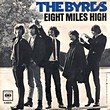|
|

From head to heart Following our retroscope series going on for several years, here we go again. Yes, for one more year! Here's Speakers' corner's cousin; From head to heart. Luna Kafé's focused eye on great events, fantastic happenings, absolute milestones, or other curious incidents from the historic shelves'n'vaults of pop'n'rock. Blowing our ears and our head, punching our chest and shaking our heart, or simply tapping our shoulder. Making us go sentimental, but not slaphappy. This moonth we put the LK spotlight on a 50-year-old platter. Last moon we 'celebrated' a seven inch from one of their 'successors', R.E.M. This time we go check out one of the 'originals', who made numerous classic songs in their prime and had a line of members during their career (through quarrels, intrigues and what not). They were miles high, visited other dimensions, and they even had a grandiose 'version' of Norway's very own 'drama king', Henrik Ibsen's "Peer Gynt" (originally with music composed by Norwegian classic composer Edvard Grieg) - adapted, adjusted, modified and transposed to fit the South-Western American plains. Fairy tales travel - they have always done so. The taming of the wild is universal. Tame the wild horse! Anyway, this legendary band was well established when they launched this, their 5th 7" single in March 1966 (later to be included on their third album). The legend lives on. These guys helped to form folk rock, psychedelic pop/rock, raga rock, and country rock as we know it in their time. As the saying goes (from their 'hippie prime'): 'Turn on, tune in, drop out!'.
Last full moon we presented R.E.M.'s most successful single, released 25 years ago. In the beginning, R.E.M. was seen as a band more than inspired by The Byrds. It seems appropriate then, to go further 25 years back to the source of inspiration. The Byrds was formed in early 1964, originally as The Jet Set, and first hit the limelight as a crossover between Bob Dylan and The Beatles. The band came from the American acoustic folk circuit in Los Angeles but changed to electric instruments after The Beatles had hit the big time in the USA that year. Harmony vocals and the sound of Jim (later to be known as Roger) McQuinn's chiming 12-string Rickenbacker guitar became the characteristics of the band in the early stages. They had debuted with an unsuccessful single for Elektra Records as The Beefeaters in late 1964. The first release as The Byrds was their electric version of Dylan's "Mr Tambourine Man", maybe more well-known than the writer's own. Released in April 1965, a few weeks after Dylan's first acoustic version had seen the light of day on his fifth album Bringing It All Back Home. The Byrds' single reached the no. 1 spot on both sides of the Atlantic by mid-1965 and instantly they were pop stars that befriended both Dylan, the members of The Beatles and other contemporary celebrities in addition to being heroes of the growing underground movement in the USA at the time that evolved into the hippie thing. "Eight Miles High" was the band's fifth single, released on 14 March 1966. It only made it to no. 14 in the American and no. 24 in the British singles charts. One reason might be that it was banned by several radio stations in the USA for being drug related. The band members stubbornly claimed it was about a flight to England and their not entirely comfortable stay there. The song was originally called "Six Miles High", the height of intercontinental flights, but eight miles sounded cooler and was also a friendly nod to The Beatles and their late 1964 hit "Eight Days A Week". Eight miles high and when you touch
down Nowhere is there warmth to be found Round the squares huddled in storms Years later The Byrds' members admitted that it was about drugs, too. They no doubt took an active part in the burgeoning drug culture among youths in America, something especially David Crosby (guitars and vocals) struggled with for a couple of decades later. Another reason for the single's commercial failure, no doubt was because it was too complex for the young pop-single buying audience. While on tour in November 1965, David Crosby played traditional Indian folk music by Ravi Shankar and jazz by John Coltrane to the others in the band bus and it soon rubbed off. The free-form guitar playing of parts of "Eight Miles High" was clearly inspired by the two, most notably Coltrane's "India", and the melody line, too, to some extent. Almost the entire characteristic melodic guitar riff that opens the song and returns midway through is nicked from "India". In his autobiography Long Time Gone (Doubleday 1988) David Crosby recall meeting up with The Beatles and him influencing George Harrison in particular to explore traditional Indian music and later befriend Shankar: '...there are people that tell me I turned him [Harrison] on to Indian music. I know I was turning everybody I met on to Ravi Shankar because I thought that Ravi Shankar and John Coltrane were the two greatest melodic creators on the planet and I think I was probably right.' The band originally recorded the two songs of the single at a studio owned by RCA in Los Angeles and later claimed they preferred this version of "Eight Miles High". Here the seemingly guitar fumbling is slightly less jazzy and free-form and slightly more melodic than on the second version, recorded at Columbia Studios that the record company insisted they had to do to release the song. Also the guitar sounds a bit sharper and more sitar-alike on the original. But the two versions are not that different. Anyhow, the song was ahead of its time, at least a pioneer of the changing of the times. Later, of course, it has been hailed as an early psychedelic masterpiece, not only due to the guitar playing. In my opinion the somewhat compressed vocals and some guitar playing seemingly running backwards just before and at the start of the second verse of the Columbia studio version adds to its reputation. There is a slightly claustrophobic, slightly dreamy feel of the song, especially at that point, until you are absorbed by it. But it's not all ground-breaking in a pop or rock connection. The start of the song with the cool bass riff followed by the aforementioned melodic characteristic guitar riff, before the fumbling gets started, seem very much inspired by The Animals and their single hit "It's My Life" that had been released the previous October. Allegedly Gene Clark (guitars and vocals) wrote most of "Eight Miles High", with some input from Crosby and McQuinn. After Clark's death in 1991, McQuinn has claimed that he was the main writer of the song. I don't know, but it seems like a crux that Clark left the band in February, a few weeks before the single was released, partly due to his fear of flying. It might to some extent explain the uncomfortable feel of the song. Apart from "Eight Miles High", Gene Clark only participated on one song on the following Byrds album Fifth Dimension. There were only four members present on the magic carpet on the front cover when it was released in July 1966. At the time, maybe it would've been a better idea commercially to have used the B-side of the single as the A-side. As with "Eight Miles High", "Why", penned by Crosby and McQuinn, was also inspired by Indian raga music. Both songs included a sitar-sounding guitar as opposed to the previous chiming sound of McQuinn's 12-string. "Why" is also under the influence of Indian, modal improvisations, but still seems to be closer to the earlier sound of The Byrds, and the melody is catchier. It was later re-recorded for the second time and included on the band's fourth album Younger Than Yesterday released in February 1967, their masterpiece if you ask me. But that's another story. Anyhow, "Eight Miles High" was the song by The Byrds that reached highest, in an innovative sense. Copyright © 2016 JP
|
| © 2016 Luna Kafé |
 The Byrds
The Byrds